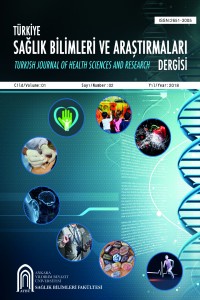Öz
Amaç: Pilor
atrezisi mide ile duodenum arasındaki bağlantının konjenital olarak
olmamasıdır. Bu makale, laparaskopik gastroduodenostomi yapılan hastanın
perioperatif dönemdeki gereksinimlerini hemşirelik bakım süreci ile ortaya
koymayı amaçlamaktadır.
Yöntem:
Bu makale olgu sunumu şeklinde tasarlanmıştır.
Bulgular: Bebek
C., ilk bebeğini 2 yıl önce pilor
atrezisi operasyonu sonrası kaybeden 31 yaşındaki annenin ikinci gebeliği
sonucunda (G2Y1) 38. gebelik haftasında ve 2500 gram
olarak sezaryen ile doğmuştur. Bebek C., Taburculuk sonrası ilk iki gün evde
anne sütü ile beslenmiştir. Bebek C., yediklerini içerir tarzda kusmaları ve
gaita yapmaması üzerine hastaneye götürülmüştür. Yapılan tetkikler sonrası
pilor atrezisi tanısı alan Bebek C. ailenin isteği üzerine bir üniversite
hastanesinin çocuk cerrahisi bölümüne sevk edilmiştir. "Laparoskopik
Gastroduodenostomi" yapılan Bebek C.'ye perioperatif dönemde bütüncül bir
hemşirelik yaklaşımı ile bakım verilmiş olup başarılı bir tedavi sonrası
taburcu edilmiştir.
Sonuç: Pilor
atrezisi nadir görülen bir konjenital anomali olmakla birlikte ciddi sonuçlara
yol açan bir hastalıktır. Cerrahi tedavi yöntemi ve kaliteli hemşirelik bakımı
ile pozitif sonuçlara ulaşılabilmektedir.
Anahtar Kelimeler
Kaynakça
- 1) Sencan A. Konjenital pilorik atrezi. Sağlıkta Birikim. 2006;1(3):1-2.
- 2) Gülsoy S, Aldemir E, Tireli G, Özbek A, Kavuncuoğlu S. Preterm yenidoğanda pilor atrezisi. JOPP Dergisi [Internet]. 2011 Aralık 14;3(1):41-44. Avaliable from: http://www.journalagent.com/iksst/pdfs/JOPP_3_1_41_44.pdf
- 3) Yıldız S, Gözen Duygu, Balcı S. Pediatri hemşireliği. Zeynep Conk, Zümrüt Başbakkal, Hatice Bal Yılmaz, Bahire Bol Işık Eds. Ankara: Akademisyen Kitapevi: 2013, p. 659-663.
- 4) Sayan A, Arıkan A, Okay ST, Şimşek FN, Bayol Ü, Özer HN ve ark. Cerrahi yenidoğanda ek anomaliler. Çocuk Cerrahisi Dergisi [Internet]. 2008 Temmuz 24; 22(3):104-110. Avaliable from: http://www.journalagent.com/cocukcerrahisi/pdfs/CCD_22_3_104_110.pdf
- 5) Darwish AA, Debauche C, Clapuyt P, Feruzi Z, de Goyet JV, Reding R. Pyloric obstruction, duodenal dilatation, and extrahepatic cholestasis: a neonatal triad suggesting multiple intestinal atresias. J Pediatric Surgery [Internet]. 2006 ;3(1):41-44. Avaliable from: https://www.jpedsurg.org/article/S0022-3468(06)00391-5/fulltext
- 6) Küçükoğlu S, Çelebioğlu A, Coşkun D. Yenidoğan kliniğinde bebeği yatan annelerin postpartum depresyon belirtileri ve emzirme özyeterlilik düzeylerinin belirlenmesi, Gümüşhane Üniversitesi Sağlık Bilimleri Dergisi [Internet]. 2014 Temmuz 15; 3(3):921-932. Avaliable from: http://dergipark.gov.tr/download/article-file/220128
- 7) Öztürk O, Demir B, İğde M, Öksüz BG, Koçyiğit A, Akyol ŞT. Sosyal pediatric kliniğinde izlenen çocukların ve annelerinin değerlendirilmesi. Orjinal Araştırma Dergisi [Internet]. 2015 Şubat 5;4(1):23-28. Avaliable from: https://docplayer.biz.tr/6574947-Sosyal-pediatri-polikliniginde-izlenen-cocuklarin-ve-ailelerinin-degerlendirilmesi.html
- 8) Bıçakçı Ü, Tander B, Çelik F, Arıtürk E, Rızalar R. Pyloric atresia associated with epidermolysis bullosa: report of two cases and review of the literature. Ulus Travma Acil Cerrahi Dergisi [Internet]. 2012;3:271-273. Avaliable from: https://www.journalagent.com/travma/pdfs/UTD-13284-CASE_REPORTS-TANDER.pdf
- 9) Kapucu S, Akyar İ, Korkmaz F. Pearson Hemşirelik Tanıları El Kitabı. 11. Basım. Ankara: Pelikan Yayınevi; 2018.
Öz
Aim:
Pyloric atresia is a congenital lack of the connection
betwen stomach and duodenum. The aim of this article that the requirements of
patient who underwent laparoscopic gastroduodenostomy in perioperative period
is to reveal with the nursing prosess.
Method:
This article is designed as a case report.
Results:
Baby C. has borned with cesarean section when he/she
was 38th week of gestational and as 2500 grams birth weight from 31-years-old
mother who lost first baby after pyloric atresia surgery. First two days after
discharge, the baby was feeding with mother’s milk. Baby C didn’t defecate and
vomited that includes what he/she eat. Therefore, the mother took to auniversty
hospital her baby. "Laparoscopic Gastroduodenostomy" was performed to
the patient. The baby received holistic nursing care on perioperative period.
The patient's discharge is made with healing.
Conclusion:
The pyloric atresia is a disorder that can cause
serious consequences. Surgical treatment and qualified nursing care is
important for positive results.
Anahtar Kelimeler
Kaynakça
- 1) Sencan A. Konjenital pilorik atrezi. Sağlıkta Birikim. 2006;1(3):1-2.
- 2) Gülsoy S, Aldemir E, Tireli G, Özbek A, Kavuncuoğlu S. Preterm yenidoğanda pilor atrezisi. JOPP Dergisi [Internet]. 2011 Aralık 14;3(1):41-44. Avaliable from: http://www.journalagent.com/iksst/pdfs/JOPP_3_1_41_44.pdf
- 3) Yıldız S, Gözen Duygu, Balcı S. Pediatri hemşireliği. Zeynep Conk, Zümrüt Başbakkal, Hatice Bal Yılmaz, Bahire Bol Işık Eds. Ankara: Akademisyen Kitapevi: 2013, p. 659-663.
- 4) Sayan A, Arıkan A, Okay ST, Şimşek FN, Bayol Ü, Özer HN ve ark. Cerrahi yenidoğanda ek anomaliler. Çocuk Cerrahisi Dergisi [Internet]. 2008 Temmuz 24; 22(3):104-110. Avaliable from: http://www.journalagent.com/cocukcerrahisi/pdfs/CCD_22_3_104_110.pdf
- 5) Darwish AA, Debauche C, Clapuyt P, Feruzi Z, de Goyet JV, Reding R. Pyloric obstruction, duodenal dilatation, and extrahepatic cholestasis: a neonatal triad suggesting multiple intestinal atresias. J Pediatric Surgery [Internet]. 2006 ;3(1):41-44. Avaliable from: https://www.jpedsurg.org/article/S0022-3468(06)00391-5/fulltext
- 6) Küçükoğlu S, Çelebioğlu A, Coşkun D. Yenidoğan kliniğinde bebeği yatan annelerin postpartum depresyon belirtileri ve emzirme özyeterlilik düzeylerinin belirlenmesi, Gümüşhane Üniversitesi Sağlık Bilimleri Dergisi [Internet]. 2014 Temmuz 15; 3(3):921-932. Avaliable from: http://dergipark.gov.tr/download/article-file/220128
- 7) Öztürk O, Demir B, İğde M, Öksüz BG, Koçyiğit A, Akyol ŞT. Sosyal pediatric kliniğinde izlenen çocukların ve annelerinin değerlendirilmesi. Orjinal Araştırma Dergisi [Internet]. 2015 Şubat 5;4(1):23-28. Avaliable from: https://docplayer.biz.tr/6574947-Sosyal-pediatri-polikliniginde-izlenen-cocuklarin-ve-ailelerinin-degerlendirilmesi.html
- 8) Bıçakçı Ü, Tander B, Çelik F, Arıtürk E, Rızalar R. Pyloric atresia associated with epidermolysis bullosa: report of two cases and review of the literature. Ulus Travma Acil Cerrahi Dergisi [Internet]. 2012;3:271-273. Avaliable from: https://www.journalagent.com/travma/pdfs/UTD-13284-CASE_REPORTS-TANDER.pdf
- 9) Kapucu S, Akyar İ, Korkmaz F. Pearson Hemşirelik Tanıları El Kitabı. 11. Basım. Ankara: Pelikan Yayınevi; 2018.
Ayrıntılar
| Birincil Dil | Türkçe |
|---|---|
| Konular | Sağlık Kurumları Yönetimi |
| Bölüm | Olgu sunumu |
| Yazarlar | |
| Yayımlanma Tarihi | 31 Ocak 2019 |
| Yayımlandığı Sayı | Yıl 2018 Cilt: 1 Sayı: 2 |


